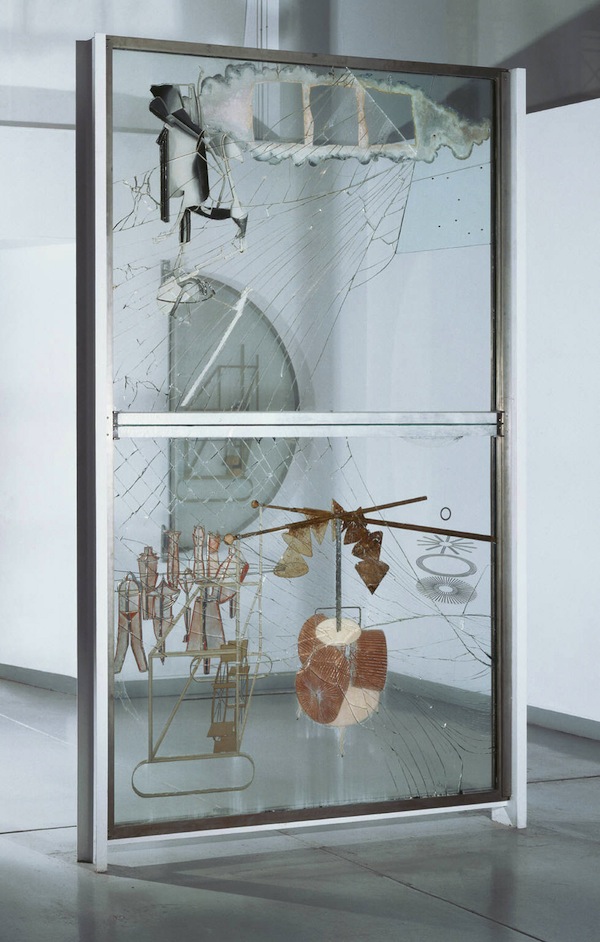
Johns’s & Rauschenberg’s visit to Philadelphia
By Jaime Bramble Schell, Philadelphia Museum of Art
The Philadelphia Museum of Art is home to the largest collection of work by Marcel Duchamp in the world, with visitors from across the globe drawn to these galleries year after year. One such visit in the late 1950s was so meaningful that without it, the Museum’s upcoming exhibition Dancing around the Bride: Cage, Cunningham, Johns, Rauschenberg, and Duchamp would not be able to happen.
It all started in 1957, just a few months after art dealer Leo Castelli opened his gallery in New York. He launched a show called New Works, featuring the art of Jasper Johns and Robert Rauschenberg. When the reviews came out, Art News referred to John’s 1955 Flags as “neo-Dada.”
The Large Glass: The Bride Stripped Bare by Her Bachelors, Even (The Large Glass), 1915-23. Marcel Duchamp, American (born France), 1887 – 1968. Oil, varnish, lead foil, lead wire, and dust on two glass panels, 109 1/4 x 70 x 3 3/8 inches (277.5 x 177.8 x 8.6 cm). Philadelphia Museum of Art, Bequest of Katherine S. Dreier, 1952. © 2012 Artists Rights Society (ARS), New York/ ADAGP, Paris/Succession Marcel Duchamp
The critic’s remarks started a chain of events that changed the course of postwar art history. Johns had no idea what “neo-Dada” meant, but he knew that in order to find out, he’d have to first understand Dada. And to understand Dada, he had to explore the works of one of the key figures of Dada himself—Marcel Duchamp. With that, Johns and Rauschenberg journeyed to Philadelphia to immerse themselves in the Museum’s Duchamp galleries.
The rooms then known as the Arensberg Galleries that they saw were just as Duchamp had installed them in 1954. The Large Glass was there then, as it is now, in front of a small north-facing window overlooking the Museum’s East Entrance courtyard and the only one of its kind within the Museum’s gallery spaces. Employing the happenstance beauty of chance and reflection, Duchamp chose this very site so that the viewer could experience the varying effects of changing light through the glass along with the movements of the everyday passerby. The terrace’s fountain further animates the scene. They also saw Duchamp’s paintings—from the early portraits to the avant-garde cubist works such as The Bride and Nude Descending a Staircase, No. 2, as well as his readymades—such as Why Not Sneeze, Rrose Selavy?.
After the visit, the two developed an enduring friendship with the older artist. In 1959, Duchamp reciprocated with a visit to their studios, where he would have seen Johns’ numbers paintings and target paintings, as well as Rauschenberg’s Combines, an art form that complicates the relationship between painting in sculpture that Rauschenberg invented in 1954.
Duchamp’s work thus became even more profoundly influential for them, and it also informed the two other artists featured in the exhibition, John Cage and Merce Cunningham. Rauschenberg had been involved with the Merce Cunningham Dance Company since 1953, serving as Resident Advisor, often in collaboration with Johns. Meanwhile, Cage was the music director. The complete and open communication between the four was now being infused with a decidedly Duchampian spirit.
In Dancing around the Bride, you will see the direct effect of this visit and the subsequent influence in Rauschenberg’s combine Bride’s Folly; several of Johns’ paintings that invocate The Bride in various constellations, and the centerpiece of the exhibition, Walkaround Time, a set created by Jasper Johns for a dance by Merce Cunningham. The set design was inspired by The Large Glass, and visitors will be recognize elements of it throughout. One of the key themes in Dancing around the Bride is to highlight both how these artists worked together and how they worked in parallel, in a community of artists who embodied the spirit of openness, chance, and trust.

Walkaround Time: Dancer Carolyn Brown in Walkaround Time, 1968. Choreography by Merce Cunningham, American, 1919-2009. Stage set and costumes by Jasper Johns, American, b. 1930. Photograph © 1972 by James Klosty
Recent Content
-
Artsarticle ·
-
Artsarticle ·
-
Artsarticle ·
